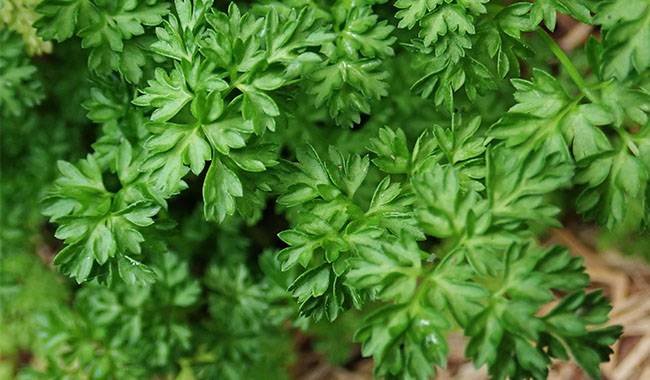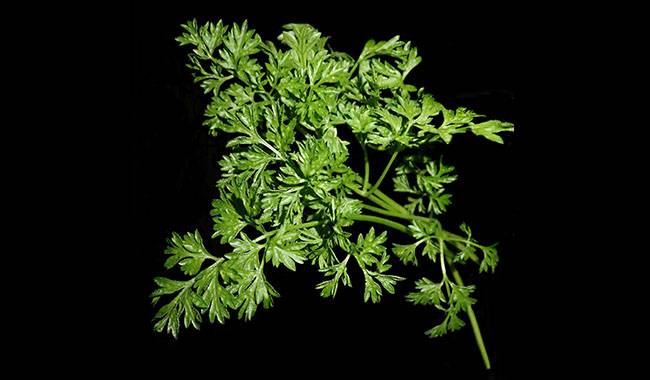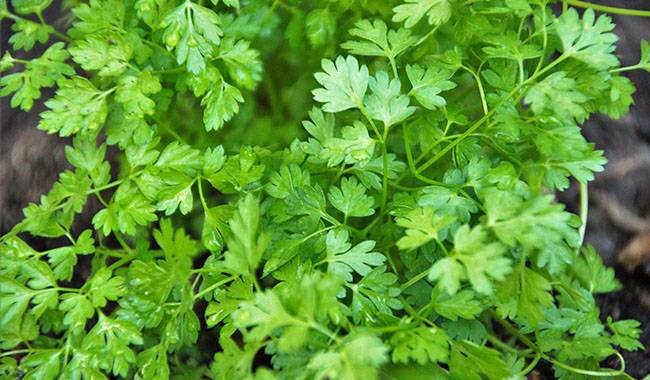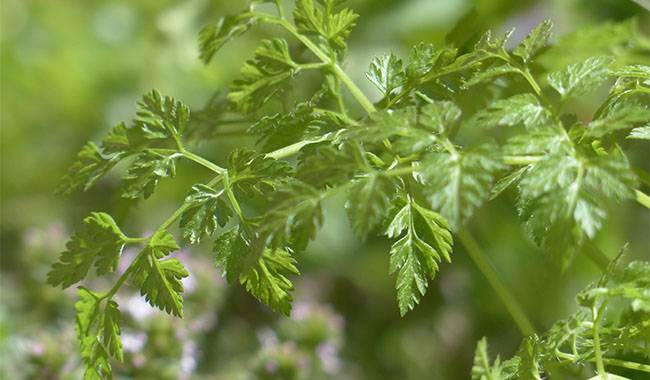
Chervil is not often found in the gardens of gardeners, and there are many friends who ask: How to growing chervil from seed? This article provides the answer.
But the young leaves of this plant give a spicy anise flavor to meat and fish dishes, chopped herbs are added to various salads and soups, they are added to omelets.
Just be aware that the herbs lose their flavor during the heat treatment process, so they are usually placed in ready-made dishes. It is not necessary to dry Chervil in the sun.
Because of its high content of ascorbic acid, a whole set of mineral salts and carotenoids, Chervil is used in folk medicine as an herb to support and restore the immune system.
CHERVIL DESCRIPTION
Although similar in appearance and taste to parsley, this herb belongs to the celery family. It is a small, branching shrub. It resembles the skeletonized greenery of ferns.
The leaves are smooth, bright green, curled, or pinnately dissected, with toothed edges. They are juicy and contain a lot of essential oils, so they smell sweet, along with a combination of parsley, fennel, and anise. chervil’s long round stems are also aromatic, erect, and branched, sometimes slightly ribbed, and up to 70 cm tall.
The skeletonized Chervil blooms with small white or pale pink flowers collected in umbels. The seeds of the plant are black or brown and have an elongated oval shape. It flowers from April to June and the fruits ripen from September to August. Skeleton Chervil is a wonderful honey plant.
This plant is native to West Asia and Russia. It is distributed in wild and cultivated forms in the territories of Europe, Central Asia, Transcaucasia, Turkey, Iran, Iraq. In some regions, wild Chervil grows on the wastelands on the banks of rivers and streams.
Chervil can also be eaten raw, boiled, or fried. This plant is also called root vegetables. It has better nutritional qualities than many other root crops and is similar in taste to parsley or edible chestnuts, but with a more subtle aniseed flavor.
USEFUL INFORMATION
Chervil is rich in vitamin C (45-60 mg), carotenoids (37 mg), mineral salts of magnesium and potassium, other useful compounds, and trace elements. The plant is rich in essential oils and bioactive substances, so it has a tonic effect.
Chervil green leaves are well digested and absorbed by the body, are good for the gastrointestinal tract, and help with astringency in case of gastrointestinal disorders. It is a source of protein, rutin, glycosides, and mineral salts.
Folk medicine considers the juice and fruit of Chervil as a means of improving digestion and as an anti-inflammatory for colds and upper respiratory diseases. Chervil is drunk in cases of vertigo, lowers blood pressure, treats the liver and kidneys, and is a diuretic. chervil is used in the treatment of jaundice, tuberculosis, and other debilitating diseases.
A decoction of fresh bamboo shoots soothes eye strain and is used for irrigation. Extract from the leaves helps those who wish to lose weight. Decoction, juice, and tincture of Chervil are used for bruises and rashes.
HOW TO GROW CHERVIL
How to grow Chervil is the most unpretentious of the pungent plants. The herb grows well in open ground and prefers long sunlight, in which conditions the stems form faster and the time before flowering is shorter.
It is very shade tolerant (can be sunless for a long time) and is suitable for growing in slightly shaded areas, such as under the canopy of garden trees. But the most productive will be the tender greens planted in spring and fall, which are characterized by short periods of sunlight and will contribute to a bumper crop of bright sunshine.
Each year it is recommended to plant Chervil in a new place. Chervil grows well in the beds after potatoes, onions, cucumbers, salads, carrots, and beets.
Any fertile soil can be used to grow Chervil. propagate this hardy plant from seed. It is more frost tolerant, so when sown in the fall, seedlings can withstand winter temperatures down to 50-53°F (10-12°C), in the rosette stage, with 5-6 pieces.
And the presence of a snow layer allows you to tolerate larger temperature drops. Therefore, when spring comes, you can put the seeds in the open ground without fear of frost. For harvesting, you can also sow Chervil in the fall, until the end of September.
Before sowing in the ground it is necessary to germinate the seeds in order to accelerate the germination of the first shoots. To do this, they are soaked: put between two layers of moist gauze and keep at a temperature of 68-77 °F (20-25 °C). But first, it is recommended to treat the seeds with a 1% solution of potassium permanganate for 25-30 minutes.
The bed soil for planting Chervil should be dug and then fertilized. For this purpose, make well-rotted manure (3-5 kg), superphosphate (40-60 g), potash (15-20 g) per 1 m2 of area.
After that, the soil should be watered, and then shallow longitudinal furrows are formed at a distance of 12-16inch (30-40 cm) to a depth of 0.4-0.6inch (1-1.5 cm), where the Chervil is sown and covered with soil. On average, about 2 g of prepared seeds are used per 1 m2 area.
When dry seeds are sown, expect 15-20 days to germinate, with pre-emergent seeds developing faster. For fresh herbs throughout the summer, sow seeds every 14 days until July 15.
The flowering period, which begins 45 days after sowing the seeds in the ground, is ready for harvesting the herbs. If the weather is hot and not watered enough, flowering will start much earlier.
When the plant grows to 2-2.5inch (5-6 cm) tall, the rows should be thinned out, leaving the strongest shoots 3-4inch (8-10 cm) apart. chervil grows quickly, and a month from the appearance of shoots, the vegetable has reached a height of 8inch (20 cm) and is ready to be picked for consumption.
Pruning should be done as close to the ground as possible and in one cut, as new shoots do not grow well after pruning.
HOW TO CARE FOR CHERVIL

Characteristics of Chervil plants The care of Chervil beds includes regular loosening of the soil, weeding and weed removal, fertilization, and maintaining sufficient soil moisture. To prevent early flowering of the plant, it should be shaded, watered regularly and heated in the sun, and watered no more than 3 liters per 1 square meter of bed.
Fertilization of Chervil should be carried out once. For this purpose, an infusion of wood ash is used, which is prepared by taking 200 g of wood ash, diluting it in 10 liters of water, and allowing it to stand for 24 hours. It can also be applied with a solution of 1 part of cowpea diluted to 10 parts of water.
With proper care, it is easy to obtain a high yield of juicy, aromatic greens. 3 kg of vitamin shoots can be harvested from 1 m2 of bed.
SEED PRODUCTION DETAILS
Chervil plants for seed production rather than vegetable harvesting should be sown immediately at the onset of spring – in March, or at the end of summer – in September. The height of good plants obtained from spring sowing should reach 12-14inch (30-35 cm) and their flowering should take place in June-July.
However, plants sown in autumn will reach a height of 23-28inch (60-70 cm) by that time, and will start flowering from the end of April and seed maturity by June. Fall plants produce twice as much as those sown in early spring.
In order to harvest an abundance of good quality seeds, part of the flowering stem on the plant is cut off, leaving only a few flowering stems for development, but the leaves are not cut off. When the umbels of the inflorescences turn white, they are cut off along with the stems and dried in a cool place. They usually ripen in late August or early September.
CULINARY USES
The useful qualities of Chervil fruit are often eaten freshly cut before flowering and stored in the refrigerator with water for 2 to 4 days. Drying and freezing will kill the rich flavor. chervil leaves are very decorative and are often used to garnish cooked, boiled or stir-fried dishes.
Chervil’s aroma evaporates quickly and heat treatment can even kill the flavor of the spices, so have 2-3 minutes at the end of cooking, or add it just before serving.
Chervil is a little-known vegetable crop, but one that deserves more attention. After all, it is a very unpretentious plant, which is used both in cooking, as a spice, and in folk medicine, helping to treat many diseases, due to the high content of various vitamins and useful substances.
But one should know that picking wild Chervil herb herbs should be done with caution because its leaves are similar to the shoots of poisonous ephedra.





